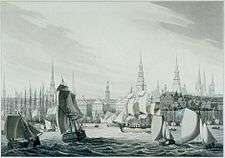Bouches-de-l'Elbe

Bouches-de-l'Elbe (German: Elbmündungen) was a department of the First French Empire in present-day Germany that survived for three years. It was named after the mouth of the river Elbe. It was formed in 1811, when the region, originally belonging partially to Bremen-Verden (which in 1807 had been intermittently incorporated into the Kingdom of Westphalia), to Hamburg, Lübeck and Saxe-Lauenburg, was annexed by France. Its territory is part of the present-day German states of Lower Saxony, Schleswig-Holstein and Hamburg. Its capital was Hamburg.
The department was subdivided into four arrondissements and the following cantons (situation in 1812):[1]
- Hamburg, cantons: Hamburg, Bergedorf, Hamm and Wilhelmsburg.
- Lübeck, cantons: Lübeck (2 cantons), Lauenburg upon Elbe, Mölln, Neuhaus upon Elbe, Ratzeburg, Schwarzenbek and Steinhorst.
- Lüneburg, cantons: Lüneburg, Bardowick, Buxtehude, Garlstorf, Harburg, Hittfeld, Tostedt and Winsen upon Luhe.
- Stade, cantons: Stade, Bremervörde, Freiburg upon Elbe, Himmelpforten, Horneburg, Neuhaus upon Oste, Otterndorf, Ritzebüttel, Jork and Zeven.
Its population in 1812 was 375,976.[1]
After Napoleon was defeated in 1814, the department were dissolved and the area was redivided between the Kingdom of Hanover (Bremen-Verden), the Duchy of Saxe-Lauenburg, and the free cities of Hamburg and Lübeck.
External links
![]() Media related to Département des Bouches de l’Elbe at Wikimedia Commons
Media related to Département des Bouches de l’Elbe at Wikimedia Commons
References
- 1 2 Almanach Impérial an bissextil MDCCCXII, p. 376-377, accessed in Gallica 24 July 2013 (French)
Coordinates: 53°35′00″N 9°59′00″E / 53.5833°N 9.98333°E
